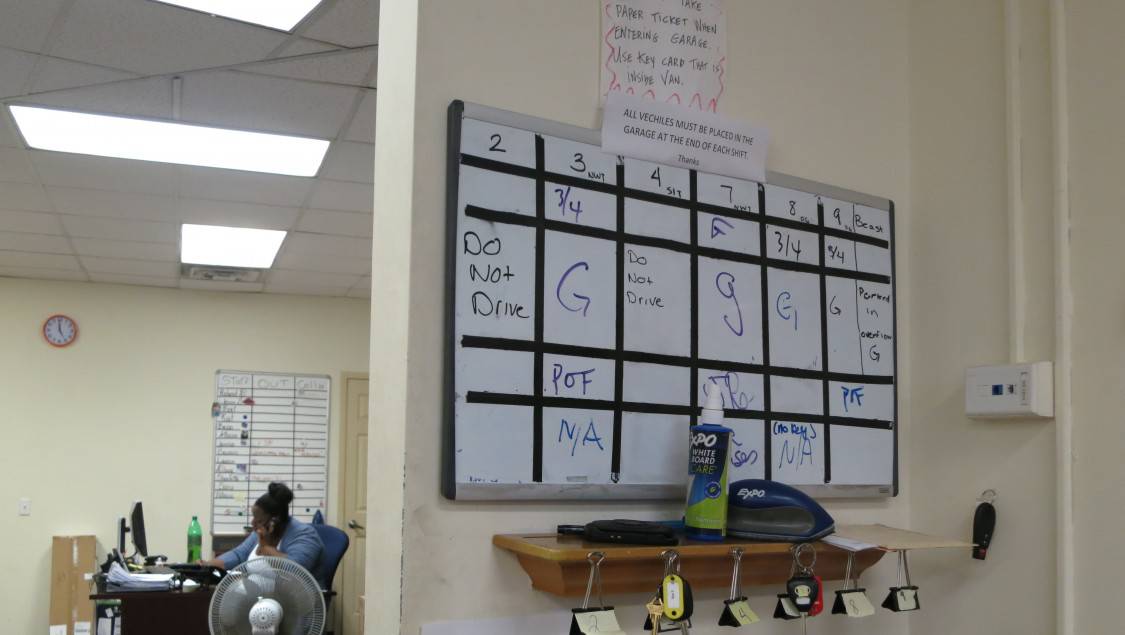
This piece was originally published in THINK PROGRESS
By Bryce Covert AUG 19, 2015
The phone rings just as Katrina Fingerson and Latoya McClary are about to leave to start their shift at the Goddard Riverside Community Center. It comes in on the line reserved for the 311 calls from concerned citizens and businesses who report homeless people on the streets and the receptionist immediately starts scribbling down details. Male, pushing a shopping cart, clothes falling off, located at 39th Street and 3rd Avenue. The man falls into Fingerson and McClary’s territory –- anywhere from 42nd Street south to the water –- so he becomes their priority as they get in the car and drive uptown.
The two, who represent the downtown evening shift at Goddard, will spend the next seven hours trying to track down the homeless of New York City living on the streets –- more than 3,000 people on a given night –- in order to record their existence while offering them services and support, starting with the man flagged by a 311 caller. Their on-the-ground work is the only way the city can wrap its arms around its sprawling homeless population, a fundamental step before it can even start thinking about how to reduce it.
And right now, that’s incredibly important to the city. In February, Mayor Bill de Blasio (D) announced that New York City would sign on to a federal initiative to end veteran homelessness, committing to housing all the city’s homeless veterans by the end of this year. In a city with nearly 68,000 homeless people, including 1,645 veterans at the end of 2014, the second-highest number of homeless veterans in a city, that’s no small feat. And to get there, the city will need to know exactly who is out there, whether they’re veterans, and what they need to get inside. It’s relying on organizations like Goddard, and therefore people like Fingerson and McClary, to be its eyes on the streets.
Other cities have gotten there first: first Phoenix and Salt Lake City housed their chronically homeless veterans more than a year ago, then New Orleans, Houston, and Las Cruces, New Mexico housed all homeless vets earlier this year. Plenty of others have signed onto the federal goal of ending veteran homelessness by the end of 2015.
But what does it mean for a city as large and crowded as New York to commit to the same goal? What does it take? And what exactly does victory look like?
Despite the gravity of their work, Fingerson and McClary spend a lot of time wrestling with a mundane concern: congested roads. “We haven’t figured out how to get past this traffic,” Fingerson laughs while idling down the FDR Drive amid a sea of cars around 5:00 p.m. “I wish that we had a hovercraft or something, a boat that could travel in the water.”
As they turn off the FDR and head under an overpass bridge, they both scan the streets and sidewalks. “While we’re driving we’re always looking,” Fingerson says. If they were to find the remnants of bedding, that would warrant a stop to check for homeless people and to record the location of anything they might come across that would indicate it had become someone’s sleeping quarters.
But the current priority is the man reported via 311. The organization is required to respond to those calls within two hours, although Fingerson notes that they hold themselves accountable to getting there in less than an hour. The two-person team parks as close as they can to the intersection and walks over as it starts to lightly drizzle. There’s no one in sight on the intersection or around it, nor anything indicating someone has claimed a spot to sleep on the sidewalk. It’s a common outcome: whoever was there has probably already long moved on, given that the call came in about a half hour ago.
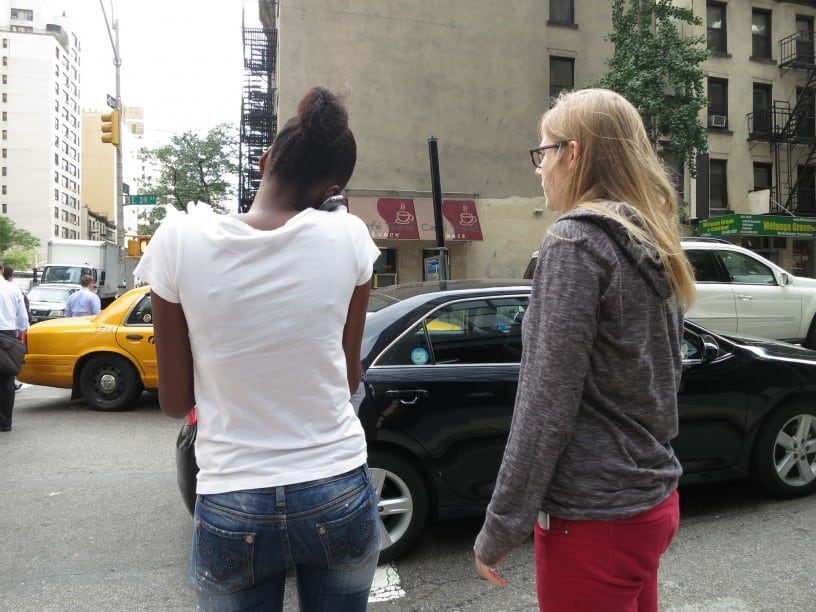
New York faces some daunting and unique challenges before it can declare “mission accomplished” on ending veteran homelessness. It’s long dealt with a housing shortage that has driven prices to record highs and a vacancy rate of just 3.45 percent. Low-income housing is even worse: less than 2 percent of units that go for $800 or less per a month are open.
“The housing stock in New York City’s always going to be an issue,” Tori Lyon, executive director of the homeless nonprofit Jericho Project, pointed out. “You could have a million HUD/VASH [Veterans Affairs Supportive Housing] vouchers [for rental assistance] but you’re not going to be able to find a million apartments.”
George Nashak, executive vice president of HELP USA, has been working on ending veteran homelessness in New York City for 20 years and has first-hand knowledge of the differences between trying to reach that goal in New York City and cheaper cities. His organization has a footprint in New Jersey, Pennsylvania, and Nevada on top of New York. “There’s a significant difference between New York and Las Vegas in that the housing markets are radically different,” he said. “So we have a much easier time rehousing veterans in Vegas.” Las Vegas had a nearly 8 percent vacancy rate as of the middle of the year.
The city is aware of what it faces. But it still thinks the goal is achievable. “It’s just going to be our grit, our stick-to-itiveness to do it as best we can,” New York City Department of Homeless Services (DHS) Commissioner Gilbert Taylor told ThinkProgress. “Yes there will be obstacles, but I don’t think they’re insurmountable. It just requires us to work harder.”
According to his department, there are currently just 973 homeless veterans in the city, a dramatic drop from 3,762 as of two years ago. Fifteen of them are going without shelter and 17 are chronically homeless. “We are definitely on track to achieve our goal of ending veteran homelessness in New York City,” Taylor said.
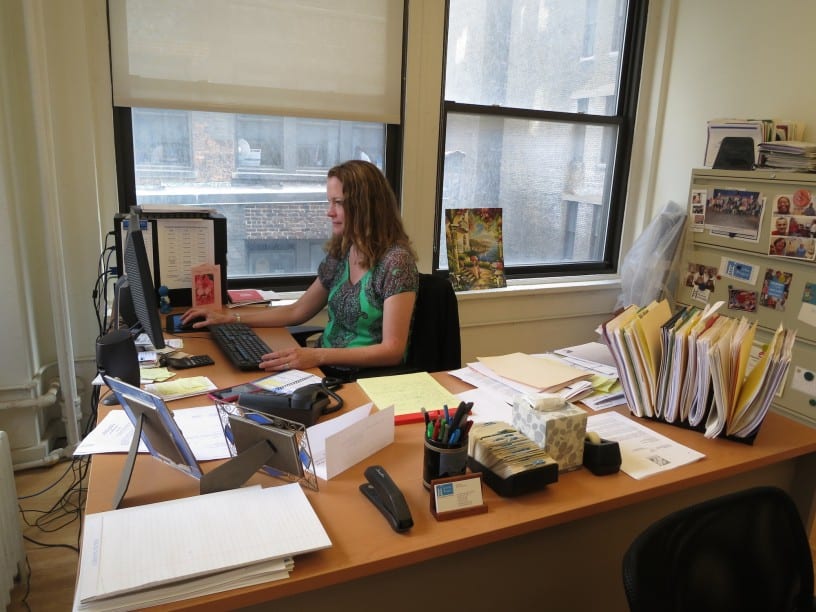
The hard work that has inched the city closer to its goal is often carried out through nonprofits. Lyon’s Jericho Project is one that has been tapped. A slight woman who is soft spoken yet fiercely passionate as she talks about her work, Lyon has been involved in trying to end homelessness in New York City through Jericho for nearly 19 years. Sitting in a sunny office in a somewhat run-down office building, she described how the organization’s initiative on veterans began in 2006 after she heard a story at a conference of a family that became homeless after the father came back from serving in Iraq. “I was just really kind of stunned to hear that somebody who had served our country in Iraq and war was coming back and being homeless,” she recounted.
Back then, there wasn’t much in place to help homeless veterans in New York City, so her group focused on building supportive housing that wraps services into permanent apartments. But since Jericho’s focus began, Lyon has seen governmental priorities shift. Five years ago, the federal Department of Veterans Affairs (VA) launched an initiative to end veteran homelessness by the end of 2015.
Then the city started working toward its version of the goal last year. That in turn brought some big changes. Lyon says the most substantial has been intensive coordination between an alphabet soup of agencies: the VA, DHS, NYC HPD (Housing Preservation and Development), NYCHA (New York City Housing Authority), and MOVA (the Mayor’s Office of Veterans’ Affairs). The mayor’s office gets briefed on progress weekly. “It used to really just be the VA,” she noted. City agencies were also flooded with about $150 million in additional funding, and the city has been diligently looking for other sources it can call on.
But more important than both of those changes is one tool: meetings. Weekly case conferences bring together Lyon, Nashak, the VA, DHS, and case managers. Everyone works together to go through the list of each remaining homeless veteran and discuss the specific barriers facing every individual and how to surmount them. Then they come up with a housing plan that will move each veteran from homelessness into a home. “It’s really kind of old-fashioned roll up your sleeves,” Lyon said. The city says it currently has plans for 87 percent of the 973 homeless veterans on that list.
Ending homelessness for any group, however, doesn’t mean there will never be homeless people again. There will always be those who experience homelessness in the future thanks to a variety of factors. The goal is to make sure that those spells of homelessness don’t last. Cities call this reaching “functional zero”: getting housing for everyone who’s currently homeless and then creating a lasting system that ensures anyone who loses housing avoids sleeping on the streets and quickly gets back into a home.
In New York City, reaching functional zero for the homeless veteran population will mean that there are no more than 300 veterans in the system at any given time and that those that do become homeless will get back into housing within 90 days. In other cities, even the definition of functional zero is different, often meaning the ability to get a homeless person into housing within 30 days. That wouldn’t fly in New York, but even its own metric may be hard to pull off. “It’s a really ambitious goal,” Lyon noted.

Karen Wharton knows as well as anyone how challenging New York City’s housing landscape can be. A small woman, she appears far larger thanks to her self-described vivacious character that radiates from her wide smile, lilting laugh, and willingness to give virtually anyone a hug.
But the constant smile can just as quickly give way to tears when she starts talking about what she’s gone through over the last two years. Despite “doing everything right,” as she puts it, she ended up a homeless veteran.
Even though she already had a degree and career in nursing, Wharton became interested in joining the military after doing charity work with the Red Cross after 9/11. “I said, you know what, I’m really interested in becoming more involved and more aware of disasters and how to act,” she said. “So I decided okay, the military is a good place to go.” She served from 2010 until 2014 in nursing and continuity of operations from San Antonio, Texas.
But when she left the military, she returned to New York City to find out that she didn’t have a home. A disaster had invaded her own life: Hurricane Sandy devastated parts of the city in 2014, including her house in Coney Island. Worse, she was told that she had missed an October 2013 deadline to get funding that she hadn’t heard about back in San Antonio. “When I came back I reached out to a lot of organizations and they told me…they have run out of money and sorry that you were in the military and, basically, it sucks to be you,” she recounted.
She moved onto her brother’s couch, staying with him and his wife and child, and started trying to get help from the VA. But that help wasn’t forthcoming either. She was told that she had to be in the system for three years before she could get assistance. Her sole focus was finding a place to live, but she was left on her own to make it happen.
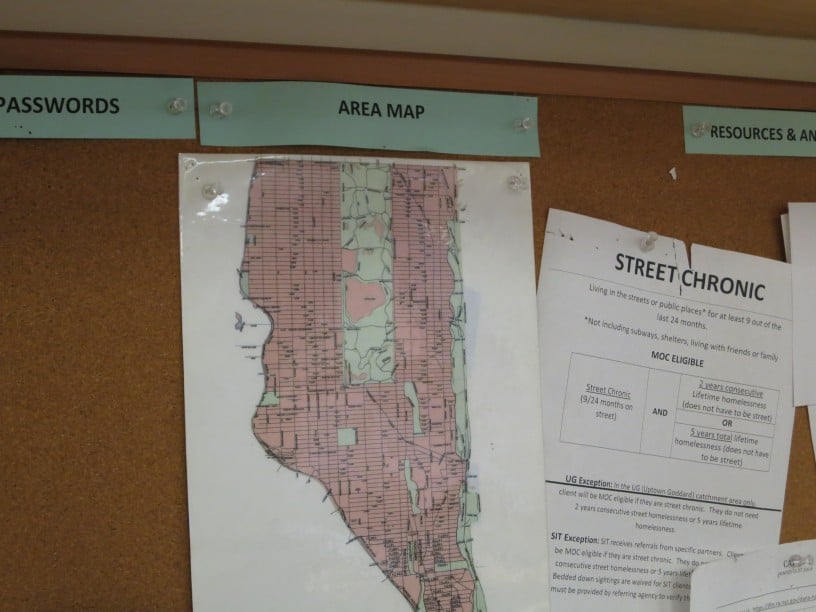
After failing to find the first person they were looking for, Goddard’s Fingerson and McClary get back in the car and crawl up the street to the next stop. They got another 311 call reporting someone on 42nd Street, and as they drive by Bryant Park, they spot him: a young man with a beard holding a sign asking for money.
They approach him from the side and gently tell him who they are and what they’re offering: a check-in to make sure he’s okay, to see if he needs anything, resources if he wants them. “I’m alright right now,” he responds. He’s not interested in services. He doesn’t take the pamphlet they offer. He doesn’t offer up much except gratitude for their visit.
They get his first name –- Michael –- and note it in their records. He thanks them and they leave. The stop takes no more than five minutes. “That was good,” they say to each other. Then they’re off to the next location.
Goddard’s outreach teams, made up of a total of about 40 people (a number that increases in the winter months when things get more dire), are responsible for contacting, cataloguing, and reporting all of the unsheltered people above ground in Manhattan; other organizations tackle those in the subway system.
For employees like Fingerson and McClary, they’re not much concerned with numbers and goals. Fingerson’s first priority is to “have them feel heard and respected… have the choice to talk to us or not talk to us,” she said. The homeless get to choose how they want to interact with Goddard employees during future visits and whether to take advantage of the resources she and her coworkers tell them about with a pamphlet. And she doesn’t mentally sort people into categories, like veteran or civilian, when trying to accomplish those things.
But right now, veteran status is one of the main things she and the other employees ask about. Anyone who’s a veteran gets fast tracked to a special initiative team within Goddard that works specifically with this group.
Some of the hardest work the city faces as it works toward its goal will come in trying to move the people living on the streets indoors, and Goddard plays a key role. “We know exactly who those clients are, we have them on our caseloads, we have street teams and subway teams and caseworkers engaging them on a very frequent basis trying to get them to come into shelter, and to ultimately move them to permanent housing,” Commissioner Taylor said.
Goddard started its veterans initiative in 2011, and Christina Narine, the director of outreach who launched the project, noted that there are still veterans they work with who don’t want to go into shelters or other housing. “We have a lot of vets [who are] just very mentally ill and resistant, folks who have been on the caseload for years,” she said. “Some are resistant because they’re very mentally ill, some are resistant because they’re struggling with substance abuse.”
Her team doesn’t force anyone into anything. “The best practice is engagement,” she noted. Their job is to check in on them regularly and get to know them person to person. “Talk with them about things other than housing, ask them what their day was like,” she said. “Eventually they come around. That’s the best way to reach these folks.”
But that of course takes time, and there’s no guarantee that they will decide to go indoors. “It’s out of our control,” she said. “There’s not much you can do until they’re ready to come in.”
Those resistant veterans are among the ones who are still homeless, counting against the city’s ability to declare victory. And it’s the people who are left who are going to take the most work. “The challenge is now that the 900 and something that are left [homeless] are, as you can imagine, the hardest to serve,” Jericho’s Lyon noted. One particular veteran that came up in a recent case conference has severe developmental disabilities, so he was only in the military for two weeks before his commanding officer realized he shouldn’t have been there in the first place. That means he isn’t eligible for VA services or the other host of resources available to veterans. “Every piece is something complicated like that,” she said.
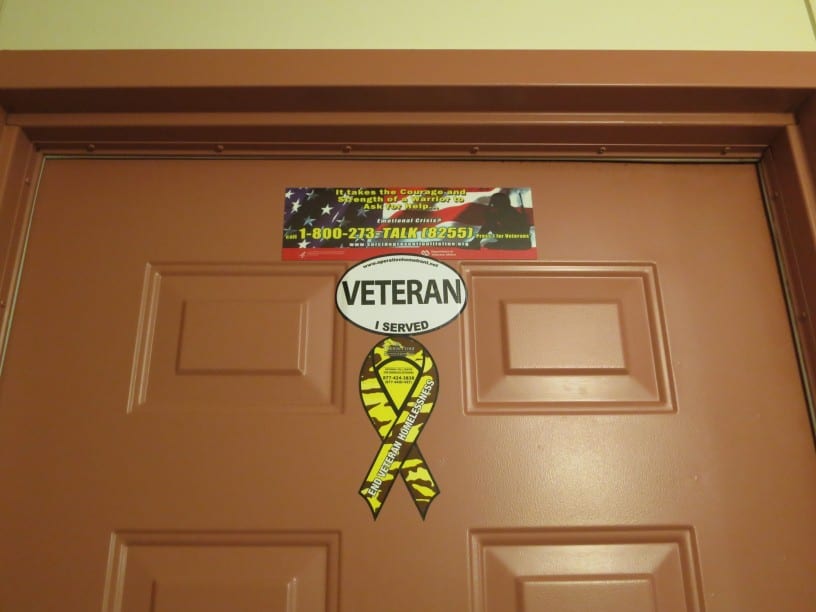
If the city does reach its goal come New Years Eve, the work is far from over.
“Mission accomplished” may be hard to maintain. Currently, most of the homeless veterans caught in the city’s intensive efforts are from the Vietnam and Cold War eras. Nashak estimates that there’s about a 10-year lag between when someone leaves service and when someone becomes homeless. “The people who are going to experience a problem in the future, they can hold it together for 10 years,” he said. “About 10 years after discharge you start to see the people who are at risk of falling into homelessness begin to do so.” That means there is a coming wave of veterans from the Iraq and Afghanistan conflicts who are likely to become homeless in the future.
The good news is that if New York reaches its goal this year, it will know exactly what to do with those veterans when they do become homeless. It’ll mostly be a matter of funding. “The concern is that this funding is maintained and is accordioned up,” he said.
Funding will also be critical for other future efforts. The city, of course, has a much larger homeless population beyond veterans, one that some have recently complained is growing despite de Blasio’s promises to address the crisis. Veterans tend to garner sympathy from both the public and politicians; it’s easy to question why someone who served his country should go without a place to sleep. But that goodwill doesn’t automatically extend to everyone who falls on difficult times. “I think personally housing a veteran is easier than housing other homeless folks,” Nashak said.
Part of the point of reaching the veterans goal is to keep the momentum going and eventually address everyone. The idea is that if advocates and agencies can prove that homelessness is not an intrinsic facet of society, but a problem that has a solution, even for one small slice, then the tactics they used on veterans can be deployed more widely. “The veterans task force has had that explicit conversation,” Nashak said. “Let’s do this and then go back to the administration and say look, this works.”
“The idea is that if we can show we can do it with veterans, then I think that it bolsters the argument…that if you have these resources we can solve this problem,” Lyon agreed. The money involved, though, is the biggest question mark. “It takes a tremendous amount of resources,” she noted. “The VA’s budget for homeless programs just grew exponentially in the past five years.” What would it take to house all of New York City’s homeless, youth, families, the disabled, and everyone else? Perhaps more than it’s ready to spend.

It took just a chance stroll down a new block in the Bronx to change Karen Wharton’s story. After one particular visit to the VA office, “I was just pretty much drowning in my sorrows because it had been such an uphill battle,” she said. As she was walking down the street, she noticed a mural on the side of an apartment complex featuring images of veterans. “I said, ‘Oh my god this is a veteran building? Let me find out if they take veterans.’”
That building was Jericho’s Kingsbridge Terrace supportive housing complex. Within three months of her decision to go inside and ask about whether she could get housing there, she had an apartment of her own. She moved in August of last year.
She takes obvious pleasure in showing off the entire building, including its gym complex, roof deck, and communal areas where residents, who are all veterans, have potlucks and grill on the barbecues. But her greatest pride is her apartment, which she calls “my castle.” A small one-bedroom with just a bathroom and a tiny kitchen area, her smile stretches even wider when inviting in guests after she throws herself onto her maroon leather couch.
The impact of this housing on her life is obvious. Since moving in, she got a job after sending out, as she estimates, more than 1,000 applications from the building’s computer room. (The building’s supportive services also include a career counselor who works with every tenant.) Even though she has a one-and-a-half hour commute, taking three different subway lines, she’s happy to be working. “It takes my mind off everything,” she said. She even turns all the subway stairs she has to climb into an opportunity for exercise.
She still doesn’t know whether she’ll ever be able to move back into her house, another topic that brings tears to her otherwise gleeful eyes. But she’s trying to move on. She’s currently getting trained in the Lean Six Sigma program and she eventually, wants to add either a PhD or MBA to other two degrees. She is planning for the future.
